Inverted ovariosalpingohisterectomy technique in cats: advantages and limitations
DOI:
https://doi.org/10.21708/avb.2021.15.3.9891Resumen
The inverted ovariosalpingohysterectomy (OSH) technique involves initial uterine removal, followed by ovarian disinsertion. The objective of this study was to compare the inverted technique with the traditional technique, characterized by initial removal of the ovaries followed by uterine resection, for evaluating the performance of the inverted OSH technique in cats. For this, 24 healthy, female cats, aged between 7 months and 5 years, with a body condition score of up to 6 points (9-point scale), divided into two equal groups: the traditional technique (TT) and the inverted technique (IT). Procedures were performed by the same veterinarians (surgeon and their assistant) as well as semi-quantitative analysis of the techniques (questionnaire related to the ease of uterine and ovarian manipulation as well as of intestinal and urinary vesicle manipulation) and descriptive qualitative analysis (technical report with the opinion of surgeons and an external evaluator). In addition, the total surgical time and positive pain response were evaluated, indicated by the changes in vital parameters observed by the anesthesiologist during surgery. Inverted technique it promoted greater ovarian exposure, allowing uterine cranial flexion to perform the ligatures, thus facilitating their manipulation, hemostasis, and section of the pedicle. Free the uterus from its ligaments to the abdominal cavity allowed greater mobilization of the conjoint. Both techniques required short operation time (average time of 16’± 1.321’ in the IT group and 15’± 0.525’ in the TT group). The presence of algetic stimulus was similar in the techniques, three animals in each group suffered analgesic rescue.
Descargas

Descargas
Publicado
Número
Sección
Licencia
Autores que publicam na Acta Veterinaria Brasilica concordam com os seguintes termos: a) Autores mantém os direitos autorais e concedem à revista o direito de primeira publicação, com o trabalho simultaneamente licenciado sob a Licença Creative Commons Attribution que permite o compartilhamento do trabalho com reconhecimento da autoria e publicação inicial nesta revista. b) Autores têm autorização para assumir contratos adicionais separadamente, para distribuição não-exclusiva da versão do trabalho publicada nesta revista (ex.: publicar em repositório institucional ou como capítulo de livro), com reconhecimento de autoria e publicação inicial nesta revista. c) Autores têm permissão e são estimulados a publicar e distribuir seu trabalho online (ex.: em repositórios institucionais ou na sua página pessoal) a qualquer ponto antes ou durante o processo editorial, já que isso pode gerar alterações produtivas, bem como aumentar o impacto e a citação do trabalho publicado (Veja O Efeito do Acesso Livre).


 Esta obra está licenciada com uma Licença
Esta obra está licenciada com uma Licença 